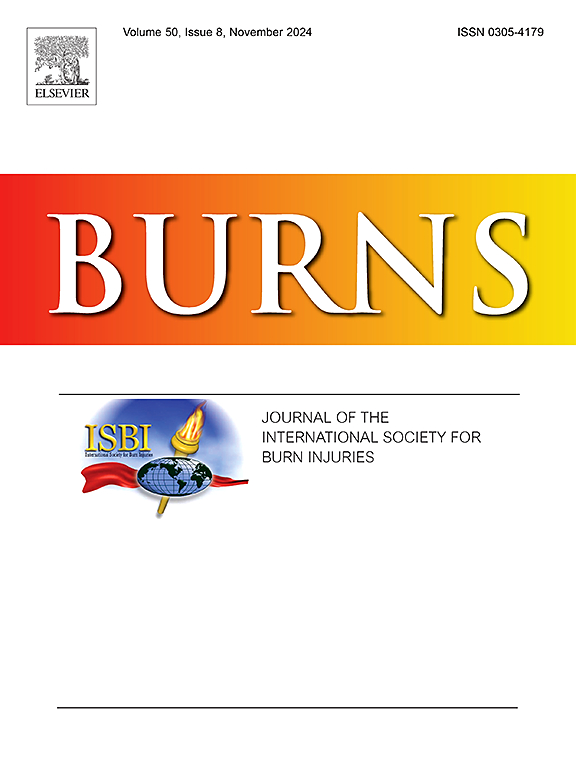From fun to frostbite: Cutaneous cold injuries linked to nitrous oxide, the experience of a tertiary burn centre in the UK
IF 2.9
3区 医学
Q2 CRITICAL CARE MEDICINE
引用次数: 0
Abstract
Background
The use of nitrous oxide (N2O) as a recreational drug has increased in the United Kingdom and consequently, the associated injuries, including frostbite injury, have also increased. The aim of this study was to investigate the incidence, pattern of injury, and management of frostbite injuries secondary to nitrous oxide use in a regional burns centre.
Methods
A retrospective cohort study was conducted of all adults referred to the Burns Centre at Wythenshawe Hospital in Manchester, UK, with nitrous oxide cannister-related contact frostbite injuries between 2014 and 2024. Data were obtained from the International Burn Injury Database, referral system, and electronic medical records. Outcome measures included demographics, injury pattern, management, and follow-up. Descriptive statistical analyses were performed.
Results
44 patients sustained frostbite injuries secondary to recreational nitrous oxide use between January 2021 to October 2024. 75 % of patients were aged between 15 and 24 years with the average age being 21.3. All patients had a delayed presentation to the Emergency Department with the average time to assessment being 12 days. The mean total body surface area injured was 0.73 % (range 0.2–2 %). The medial thigh was the commonest site of injury (63.6 %). 26 (56.1 %) patients sustained full thickness frostbite injury. 21 patients were lost to follow-up, 1 required skin grafting, and the remaining 23 patients had an average healing time of 87.9 days.
Conclusion
The recreational use of nitrous oxide has risen in recent years and so has the incidence of associated cold injuries. The patients are typically young, or even children; however, restricting the use and distribution of nitrous oxide is challenging. Greater emphasis needs to be placed on educating this age group to address this public safety concern. Additionally, national data collection would be useful in investigating the impact within the UK.
从好玩到冻伤:与一氧化二氮有关的皮肤冷伤,英国三级烧伤中心的经验
在英国,一氧化二氮(N2O)作为消遣性药物的使用有所增加,因此,包括冻伤在内的相关伤害也有所增加。本研究的目的是调查区域烧伤中心使用一氧化二氮引起的冻伤的发生率、伤害模式和管理。方法回顾性队列研究纳入2014年至2024年间在英国曼彻斯特威森肖医院烧伤中心就诊的与氧化亚氮罐相关的接触性冻伤的所有成年人。数据来自国际烧伤数据库、转诊系统和电子病历。结果测量包括人口统计学、损伤模式、管理和随访。进行描述性统计分析。结果在2021年1月至2024年10月期间,有44例患者因娱乐性氧化亚氮引起冻伤。75% 患者年龄在15 ~ 24岁之间,平均年龄21.3岁。所有患者均延迟到急诊科就诊,平均评估时间为12天。平均总体表损伤面积为0.73 %(范围0.2-2 %)。大腿内侧是最常见的损伤部位(63.6% %)。26例(56.1% %)患者发生全层冻伤。失访21例,需植皮1例,其余23例平均愈合时间87.9天。结论娱乐性氧化亚氮的使用近年来呈上升趋势,相关的冷损伤发生率也随之上升。患者通常是年轻人,甚至是儿童;然而,限制一氧化二氮的使用和分配是具有挑战性的。需要更加重视对这一年龄组的教育,以解决这一公共安全问题。此外,全国数据收集将有助于调查英国国内的影响。
本文章由计算机程序翻译,如有差异,请以英文原文为准。
求助全文
约1分钟内获得全文
求助全文
来源期刊

Burns
医学-皮肤病学
CiteScore
4.50
自引率
18.50%
发文量
304
审稿时长
72 days
期刊介绍:
Burns aims to foster the exchange of information among all engaged in preventing and treating the effects of burns. The journal focuses on clinical, scientific and social aspects of these injuries and covers the prevention of the injury, the epidemiology of such injuries and all aspects of treatment including development of new techniques and technologies and verification of existing ones. Regular features include clinical and scientific papers, state of the art reviews and descriptions of burn-care in practice.
Topics covered by Burns include: the effects of smoke on man and animals, their tissues and cells; the responses to and treatment of patients and animals with chemical injuries to the skin; the biological and clinical effects of cold injuries; surgical techniques which are, or may be relevant to the treatment of burned patients during the acute or reconstructive phase following injury; well controlled laboratory studies of the effectiveness of anti-microbial agents on infection and new materials on scarring and healing; inflammatory responses to injury, effectiveness of related agents and other compounds used to modify the physiological and cellular responses to the injury; experimental studies of burns and the outcome of burn wound healing; regenerative medicine concerning the skin.
 求助内容:
求助内容: 应助结果提醒方式:
应助结果提醒方式:


